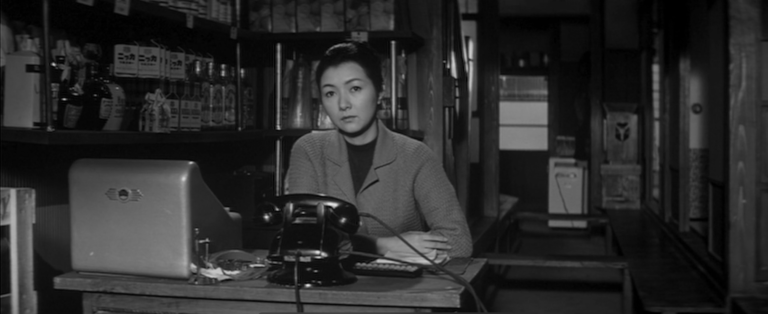Tokyo’s lonely sun has two solitary witnesses. One is all out of breath, the other is equally out of composure. Taeko, walking ungainly with the weight of newfound puberty and Hirota, frozen with newfound love. In what adulthood sees as an insultingly brief moment, their childhood sees a lifetime. They draw cards from each other’s chests, smiling infectiously as it matches theirs. But the harmony of that moment doesn’t last long – the older Taeko wakes up just as the younger jumps onto her bed. In Takahata-san’s films, childhood is always interrupted – sometimes stolen, sometimes intruded. In Only Yesterday, Taeko’s childhood suffers from the worse predicament of insignificance. Young, she looks forward to a life of work. Old, she looks back to see what she waited for. In a sense, her childhood is ruptured too – it’s stretched too thin with selective blips that prevent it from snapping. Though I’ve spoken about this quality in his films before, the salience of childhood manifests as a clever trapdoor in his hands. It’s merely an access point to speak to adults themselves – like me and you – who go in search of levity and return with questions over the smaller moments of our tender years.
Only Yesterday embodies this signature of Takahata-san with a wistful fullishness. The subject of the film and the mode of narration was viewed by the film’s financiers as a case of squared pegs and round holes. Who would wish to watch an animation that speaks for a lengthy two-hour runtime about the indecisiveness of a career woman? But, as he has done before and after, the story and even more importantly the skeins of childhood that hold it together deserved a stronger creative arm – one that can be exercised with lesser flashiness on Ghibli’s canvas. The original work was a periodical strip piece that spoke of a young girl’s memoirs centered around the onset of adolescence in the 60s. Its form and the expansiveness of its content made it prohibitive to perform a direct adaptation; Miyazaki himself tried before passing it on to Takahata whom he thought to be more able for this subject. To abridge the expansiveness, he fashioned the housing narrative for Taeko’s childhood through the trip to Yamagata. Unsurprisingly given Takahata-san’s nature, the production team overshot their deadline and Only Yesterday made it to the screens only in 1991.
With three of his films now imprinted delicately in my memory, I’m able to appreciate Only Yesterday in a different light. Unlike the circular narrative of Grave of the Fireflies and the linearity of Princess Kaguya, the film banks on Taeko’s childhood haphazardly. She’s rifling through recollections of little and much moment and their presence is felt even as the whitish world of memory crumbles inwards into her ongoing journey. “I didn’t intend for my ten-year-old self to accompany me on this trip,” her mind prattles as a young Taeko, eyes half-hidden behind curtains, watches on. The world of childhood was but a platform for us in Fireflies and Kaguya, one where we watched the world inside out. Inversely, through Taeko, we watch it outside in. Both forms are appropriate for what they wish to speak of – war’s folly through a child’s eye or human desire seen through a naïve beholder. These were great introspective platforms. Here, however, the interiority of the narrative reverses the question. What would I – my ten-year-old self – make of the current life that I have manufactured for myself?
There is, nonetheless, a marked difference in the new framing narrative. Films that retrieve and reveal moments from the past often center around acerbic moments – to lend their pivotal characters stronger motives. But, throughout the film, there are only pale moments viewed by Taeko and no acrid note punctuates them. Even when she’s pulled and slapped by her father, a very rare occurrence, there isn’t an unduly importance attached to it. “But that child isn’t normal!” her mother remonstrates elsewhere as she descends the stairs. There are larger strings of neglect and dismay that Takahata refrains from pulling. Taeko, like much of her retinue, has had a normal childhood with its share of rough patches, but her current life wasn’t one constructed in defiance. She’s merely lived in Tokyo all her life; purses and the odd pineapples are all she has known. Her predilection for the pastoral is as much a puzzle for her as it is for us. “I’ve envied friends who’ve had family in the countryside,” are her only thoughts as she steps off the crowded Tokyo metro.
However, what one usually sees in films that pit city life against the country remains firmly outside of Only Yesterday. Though there is no cause for Taeko herself to sneer about life in the country, her hosts, too, don’t take to mockery. In its search for an anchoring purpose, the film doesn’t pull life in Japan’s cities beneath that of life in Yamagata. “Anything worth struggling for will be hard work,” Toshio sighs, “isn’t it the same in the city?” Taeko whispers an unsure yes. That exchange is one of the few instances where the contrast is brought up and it swiftly brushes aside differences. People, regardless of where they live, pour much from within to create their exteriors. Little can be accomplished by belittling either way of life. But there’s a perfunctory charm that evades the city, taking shelter in these rustic expanses. Taeko wishes for it, or else she wouldn’t be here. But the point that Takahata-san repeatedly makes throughout the film is that this isn’t a fairytale switch. “It’s finally great to be in the middle of nowhere,” she notes, stretching the tired limbs of a car journey. “Nowhere, huh?” says Toshio, affronted. But he chooses to point out to her how untrue her urban misconception is – for everything she beholds is the work of man. There are living traces of man’s work against the grain, against the forest, against the streams. Man and nature have worked together, not against each other as they do in Tokyo. The gaze of the film consistently dispels one’s urge for the romanticist’s escapade, reminding us that there isn’t one. The perfunctory charm exists, but it does so not because nature prevails against man. Isolating the film as a search for what pulls this charm to the country and not broadening it to be a case for the country against the city is what makes it far more accessible and pleasant.
So, if this charm doesn’t exist in the city-dweller’s misconception of less stressful work, where does it exist? Much of the film unfurls in answering this question without ever being direct, through the medleys of Eastern European music, dewed safflowers, and the sun-soaked crimsons playing against the greens of Yamagata’s planes. Amidst all these is a serene pastoral quality – one that she is unable to verbalize but grows increasingly fond of. Sat with a sweeping view of their fields, she exchanges to Toshio about her whimsical aspirations to become an actress, one that was denied to her by her father. Plucking the grass as one does when one is unsure of oneself, Toshio too acquiesces to his early ambitions for a life in Tokyo – his desire being thwarted by his own. Agreement with his father, he says, came later in life – after the early years of stoked envy towards his peers who boarded that train to Tokyo. Life is now a small collection of little wants. In verbalizing his modest ambitions, he brings Taeko to the realization that she has unwittingly harbored on her shoulder. Her life, despite all the wants of her childhood, is now one strikingly similar to his. In a flash, the childhood of yesterday, its measured unfulfillment, and the grudging concessions she made to be content make her life clearer. Her ten-year-old self now circles her to return to a life where wants languished before becoming unnecessary.
But the sweet poignancy of these final passages is merely the aftertaste of the world Takahata-san created for young Taeko. The colors of her childhood are selectively rich and broadly austere, precisely how most of our memories present themselves. One always notices a color pattern that is never fully developed in Takahata-san’s films but the entirety of this sequence pairs well and with intention against the rigor displayed in Taeko’s present. In many instances, the colors are blotted – as one sees in the sun and the trees. Place it against the odd precision of her present, with her face betraying cheekbones as she freezes with laughter. As these two stylistic choices play together over the long runtime, the smaller moments where she steals a smile remind you of how distant her childhood is. It reminds me of how Kurosawa fixed an odd habit to his principal characters – the restless shoulders from Yojimbo – for us to spatially spot a character. Here, varying that device, Takahata uses physiognomic changes to mark age. His films shine much in the way Kurosawa’s do – in the smaller details, often painless to execute, but lasting in purpose. The sparse colors, and the selective attention-to-detail, all make his frames glutinous, and your eyes cotton on to their essence with ease.
On a more personal note, I have to ask myself the question as to why I feel it necessary within myself to forgive the underdeveloped narrative tails on either side of the film. Much of Taeko’s dissatisfaction with her current life and her sudden justification to exit her train to Tokyo can leave the normal viewer with questions as to the entirety of her stay in Yamagata. True, the film does little in the way of displaying the causes of her current dilemma, nor anything more than a surface-level whim for her decision to turn back. There are blanks – intentional or unintentional, I cannot divine – that Takahata-san has left for the viewer to fill. It engendered a much larger question within me – to what extent am I ready to forgive films that let me fill in the remaining blanks, and do I prefer such films? It’s hard to say, but in the case of Only Yesterday, I felt this to be true. Much like Taeko, I find myself questioning urban domicile and unlike her, I am aware of my reasons – at least at the level of sensation if not thought. In other films that I’ve enjoyed much, the justification for characters being in certain circumstances is often given lip service – most of Wong Kar-Wai’s films come to mind – yet much of what I’ve felt or seen elsewhere played the prelude to his explorations of conflict. So, to some extent, I do believe that it is permissible to leave blanks that aren’t too gaping for the viewer to come in and interpolate. Regardless, speaking of Only Yesterday, the film accords much respect to its viewers by not beseeching them to see what its maker wishes them to see. This odd, under-noticed film about a woman finding herself that one usually expects to see as a play or filmed enactment merits best from the unusual choice of animation. To lie forever? To live forever? Even if you don’t find yourself where Taeko does, like a child that scribbles into an activity book, you might find something about yourself here.





